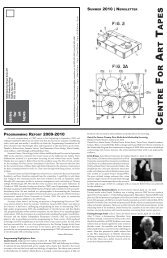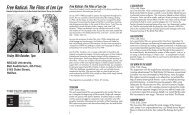video is a perceptual prosthetic - Centre for Art Tapes
video is a perceptual prosthetic - Centre for Art Tapes
video is a perceptual prosthetic - Centre for Art Tapes
You also want an ePaper? Increase the reach of your titles
YUMPU automatically turns print PDFs into web optimized ePapers that Google loves.
more obviously d<strong>is</strong>placed depiction of reality.Video seems very real, indeed.A lot has happened since the late 1960sand early 1970s. Video <strong>is</strong> no longer exotic.Besides becoming ordinary and common(transparent), <strong>video</strong> has been engulfed bya flood of so-called ‘new media.’ The digitaltrans<strong>for</strong>mation of all analog technologies,begun in the early 1980s, has permitted theconvergence of previously d<strong>is</strong>crete technologiesto the extent that now our smart phonesare jukeboxes, photographic cameras, movietheatres, text generators, teletype machinesand <strong>video</strong> transceivers. And yes, we can talkon our mobile phones. Wireless telephony <strong>is</strong>radio.Video as a technology and medium <strong>is</strong> on itsascent, nearly fifty years after its emergencein the mid-1960s. Digital <strong>video</strong> simulates all ofthe principle qualities of analog <strong>video</strong>, withoutthe signal degradation inherent in analog<strong>video</strong> postproduction, d<strong>is</strong>tribution and exhibition.The proliferation of <strong>video</strong> productiontools, the ‘digital SLR revolution’ and the useof point and shoot still cameras and mobilephones as <strong>video</strong> camcorders have put <strong>video</strong>production capabilities into an unprecedentednumber of hands. Webcams and the use ofteleconferencing technologies like Skype haveushered in the long anticipated picture-phoneor <strong>video</strong>phone.Video, as a <strong>perceptual</strong> instrument, <strong>is</strong> mosteffectively used as a process-based technologicaldevice, not as a tool <strong>for</strong> producing fin<strong>is</strong>hedworks. Video <strong>is</strong> an instrument <strong>for</strong> examining afield of data in real time. It <strong>is</strong> a tool <strong>for</strong> d<strong>is</strong>coveringin<strong>for</strong>mation, not making it.When <strong>video</strong> became an accessible technologyin the late 1960s with the introductionof portable ½-inch analog tape machines, itwas a primitive audio/v<strong>is</strong>ual technology thatcould not compete with other more advancedtechnological media in terms of resolution ofimage and sound. It paled in compar<strong>is</strong>on with16 or 35mm film or photography in terms ofimage resolution. In other words, <strong>video</strong> didnot do a very good job in representing theworld in high fidelity. Photochemical mediawere very mature when <strong>video</strong> was born. Whenone looked and l<strong>is</strong>tened to a <strong>video</strong> recording,he or she saw the medium in its opacity andinitially it was not a pretty sight. The imageThe <strong>Art</strong> Style Computer Processing System was presentedas a text-based <strong>video</strong> art work titled “TheoreticalTelev<strong>is</strong>ion” in 1977. Still from “Theoretical Telev<strong>is</strong>ion,”Tom Sherman, <strong>video</strong>, 28 minutes, 1977.8Tom Sherman, as he appeared in “Theoretical Telev<strong>is</strong>ion”in 1977. Still from “Theoretical Telev<strong>is</strong>ion,” Tom Sherman,<strong>video</strong>, 28 minutes, 1977.






